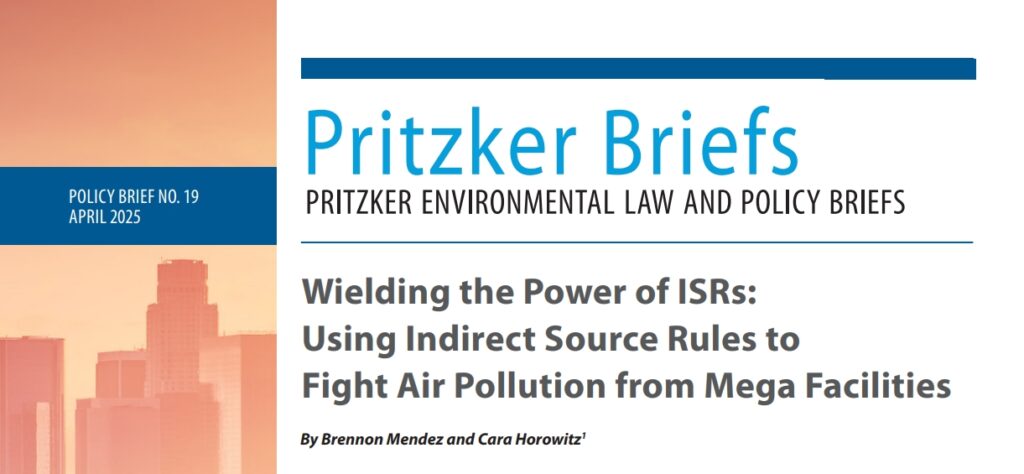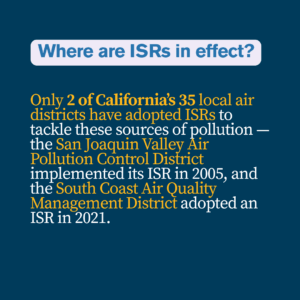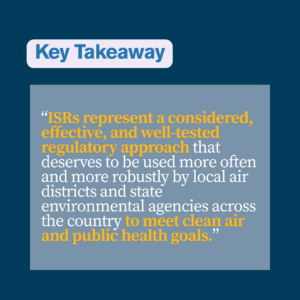Unsheathing a Weapon for Clean Air: ISRs
New UCLA Law report focuses on how to use Indirect Source Rules to fight pollution from mega facilities.

We don’t have to tell you that air pollution remains a serious threat to communities across California, from Oakland to the Inland Empire. But what if we told you that most air regulators are fighting air pollution with one hand tied behind their back, unnecessarily? It turns out there is a powerful weapon that can clean up the air that you and your family breathe, but only two of California’s 35 local air districts are using it. This is the subject of the UCLA Emmett Institute’s latest report in the Pritzker Brief series, published today.
Indirect source rules, known as ISRs, are robust but underutilized regulations that can reduce the indirect air pollution spewed around big facilities like warehouses, logistics centers, or ports. Think about the tailpipe fumes coming from long lines of big rigs or the emissions created by diesel-burning construction equipment — that is, pollution coming from mobile sources that are drawn to your neighborhood by a stationary source. ISRs are innovative regulations that allow policymakers to attack pollution emitted by mobile sources via rules that apply to facilities themselves.
 ISRs are especially powerful because local air districts don’t have very many effective ways to tackle pollution from mobile sources, which is typically the province of the federal government. With President Trump promising to roll back federal pollution standards, ISRs are on the verge of becoming the hot new thing in some policy circles. They are increasingly attracting the attention of community groups, advocates, air pollution regulators, and lawmakers as important regulatory tools, both inside and outside of California. ISRs are currently the subject of proposed legislation in New York, New Jersey, California, and New York City. But for the most part, these legislative campaigns haven’t yet received much attention.
ISRs are especially powerful because local air districts don’t have very many effective ways to tackle pollution from mobile sources, which is typically the province of the federal government. With President Trump promising to roll back federal pollution standards, ISRs are on the verge of becoming the hot new thing in some policy circles. They are increasingly attracting the attention of community groups, advocates, air pollution regulators, and lawmakers as important regulatory tools, both inside and outside of California. ISRs are currently the subject of proposed legislation in New York, New Jersey, California, and New York City. But for the most part, these legislative campaigns haven’t yet received much attention.
ISRs have received relatively little attention from air regulators, too. Only the San Joaquin Valley Air Pollution Control District and the South Coast Air Quality Management District, out of California’s 35 local air districts, have adopted ISRs, despite the pervasiveness of air pollutants like nitrogen oxides (NOx) and particulate matter (PM10 and PM2.5). In those two air districts that have adopted this pioneering form of regulation, ISRs have led to resounding success.
In 2005, regulators in the San Joaquin Valley — an area hardly known for spearheading progressive environmental policies — became the first air agency in the nation to adopt a comprehensive indirect source rule. That ISR requires building developers to reduce by certain percentages the NOx and PM10 emissions from mobile sources associated with a development, whether it’s a shopping mall or a parking structure or an apartment building, during both its construction and operation. The San Joaquin Valley’s ISR has been remarkably successful and has been credited with avoiding tens of thousands of tons of NOx and PM10 emissions since its adoption — improving air quality for residents.
More recently in 2021, South Coast adopted an ISR that aims to reduce smog-forming emissions by 10-15 percent from warehouse-related sources, such as freight trucks and cargo-handling equipment. Though critics had speculated that the Warehouse ISR might harm industry if adopted and lead to warehouse closures, the number of warehouses in the South Coast Air Basin has grown robustly since the rule’s adoption, with South Coast’s analysis revealing that the ISR “had minimal impact on warehousing demand.” In fact, South Coast concluded that over the last 10 years, the total inventory of warehousing space increased by 41%.
We recently researched how ISRs have been drafted, passed, and implemented by air districts, and took a hard look at whether there were legal reasons why communities around the country haven’t yet adopted them. Spoiler alert: We didn’t find any. What we found is that ISRs are legally sound tools that air districts and states could adopt widely and swiftly. The ISRs of both San Joaquin Valley and South Coast withstood legal challenges in both state and federal courts. Judges, policymakers, and advocacy groups have all recognized the potential that ISRs have to empower local air districts and states to better comply with the federal Clean Air Act and related state statutes, meet ambitious emission reduction targets, and reduce harms to community health. Because ISRs are a flexible regulatory tool and are often designed to allow regulated entities to comply by choosing from a curated menu of air-improving measures, policymakers can advance critical public health goals when selecting these measures — prioritizing the most-urgent needs of frontline communities disproportionately harmed by air pollution.
 The bills currently under consideration in the New York and New Jersey legislatures, as well as in the New York City Council, show how political leaders can encourage, or require, environmental regulators to do more with the set of regulatory tools addressed in our paper. State legislatures should also consider whether it would be useful to clarify aspects of state law, where that law may be unclear with respect to a government entity’s legal authority to adopt ISRs. For example, in California there is some question about whether the state’s Air Resources Board may adopt a statewide ISR, and under what circumstances. The California legislature could easily resolve this question in favor of statewide authority, as proposed in AB 914 (by Assemblymember Robert Garcia), which would confirm the state Board’s ability to adopt ISRs alongside local air districts.
The bills currently under consideration in the New York and New Jersey legislatures, as well as in the New York City Council, show how political leaders can encourage, or require, environmental regulators to do more with the set of regulatory tools addressed in our paper. State legislatures should also consider whether it would be useful to clarify aspects of state law, where that law may be unclear with respect to a government entity’s legal authority to adopt ISRs. For example, in California there is some question about whether the state’s Air Resources Board may adopt a statewide ISR, and under what circumstances. The California legislature could easily resolve this question in favor of statewide authority, as proposed in AB 914 (by Assemblymember Robert Garcia), which would confirm the state Board’s ability to adopt ISRs alongside local air districts.
These are challenging times for environmental and public health protection, and it’s no time to be leaving good air pollution tools sheathed. We predict that you’re going to hear a lot more about ISRs very soon.
Read the report.